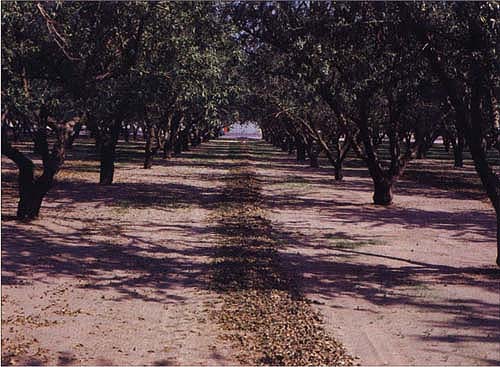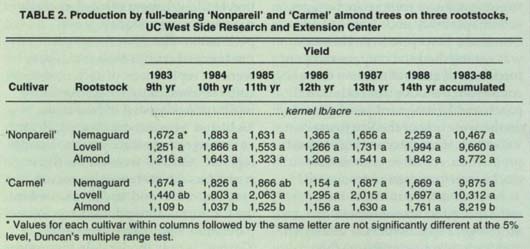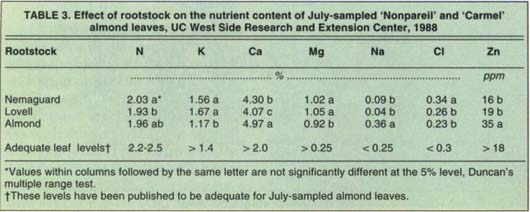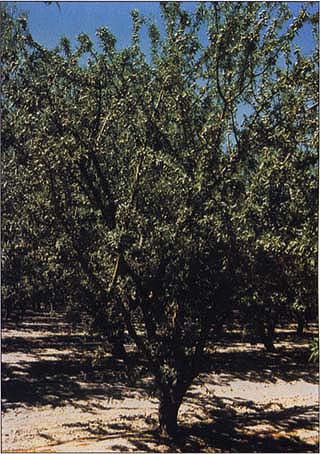All Issues
Almond trees grown on peach rootstock initially more productive
Publication Information
California Agriculture 50(4):29-31. https://doi.org/10.3733/ca.v050n04p29
Published July 01, 1996
Abstract
In trials conducted from 1975 through 1988, ‘Carmel’ almond trees on Nemaguard and Lovell peach seedling rootstocks frequently had significantly higher yields than trees on almond seedling rootstocks, but there was no significant difference in yield between the two peach rootstocks. Lovell rootstock produced larger trees than Nemaguard or almond rootstocks, particularly with the ‘Carmel’ cultivar. Leaf analysis showed that trees on almond root-stock had lower potassium and magnesium, and higher sodium, calcium and zinc levels than trees on the peach rootstocks.
Full text
At harvest, nuts were knocked to the ground, picked up and field weights obtained. A subsample was used to determine the number of nuts per pound of field weight and was then cracked out to determine kernel weight and final yield for each replication.
Leaves were collected in July and analyzed to determine the effect of rootstock on tree nutritional status.
Rootstock selection is an important decision when planting an almond orchard. Rootstocks can affect tree size, precocity, productivity and nutrient uptake as well as anchorage, soil adaptability and disease and nematode susceptibility. This trial was established to compare the performance of almond trees on three common rootstocks: almond, Lovell peach and Nemaguard peach growing on the west side of the San Joaquin Valley, an area of expanding almond production. All three of these root-stocks were propagated from seed.
Nemaguard is known to have resistance to root knot nematode, Meloidogyne spp., while the other two rootstocks are susceptible to this nematode. Almond rootstock is deeper rooted and is more drought tolerant than the two peach rootstocks, but is more susceptible to Phytophthora crown and root rot and to crown gall caused by Agrobacterium tumefaciens.
Three rootstocks, two cultivars
This rootstock trial, planted in 1975 and continued through 1988. was conducted at UC's West Side Research and Extension Center in Fresno County. The orchard was on a Panoche clay loam soil and was drip irrigated. Root knot nematodes were not a problem at this location.
Five almond cultivars, ‘Nonpareil’, ‘Carmel’, ‘Harvey’, ‘Jeffries’ and selection U.C. 3–63, were planted in single rows to ensure adequate cross-pollination. The three rootstocks were randomized within each row. There were six replications of each rootstock-cultivar combination. Each rootstock replication consisted of four trees. Yield and tree-size data were collected and analyzed separately from ‘Nonpareil’ and ‘Carmel’ trees on the three rootstocks. These two cultivars are very important and widely planted in the California almond industry. ‘Nonpareil’ is a vigorous cultivar and ‘Carmel’ is only moderately vigorous.
These trees were grown under typical cultural practices (pruning, pest control and so on) for almond production. Mature trees in this trial received yearly nitrogen fertilizer applications of approximately 200 pounds of actual nitrogen per acre (2.7 pounds per tree). Zinc sprays were applied in the fall when symptoms or leaf analysis indicated the need.
We collected nut yield and tree-size data annually from 1979 through 1988. To gauge tree size, trunk circumference was measured while the trees were dormant and converted to cross-sectional area. We collected 100 leaves from each replication (25 leaves from each tree) of ‘Nonpareil’ and ‘Carmel’ in July 1988. These leaf samples were analyzed by standard procedures for nitrogen, potassium, phosphorus, calcium, magnesium, sodium, chloride, boron, zinc, manganese and copper to determine rootstock effect on tree nutritional status.
TABLE 1. Production by ‘Nonpareil’ and ‘Carmel’ almond trees on three rootstocks during early bearing years, UC West Side Research and Extension Center
TABLE 2. Production by full-bearing ‘Nonpareil’ and ‘Carmel’ almond trees on three rootstocks, UC West Side Research and Extension Center
Effects of rootstock
Table 1 shows the effect of root-stock on early production (the 5th through 8th growing seasons). Trees on the two peach rootstocks tended to produce higher yields than trees on almond rootstock during the early bearing years. Yield differences among rootstocks for Nonpareil were not significant. With ‘Carmel’, trees on almond rootstock produced significantly less than trees on the two peach rootstocks in 1981 and 1982. Trees on almond rootstock reportedly begin to bear late, and this was substantiated with the less vigorous ‘Carmel’ but not with ‘Nonpareil’. During these early bearing years there was no significant difference in production between trees on the two peach rootstocks, although trees on Nemaguard had higher yields than those on Lovell.
Full-bearing trees (9th through 14th growing seasons) showed a pattern similar to that of the young trees. With ‘Nonpareil’ there was no significant difference in production among trees on the three rootstocks (table 2). Yields of ‘Carmel’ trees did not differ between the two peach rootstocks. ‘Carmel’ trees on Nemaguard root-stock in 1983, on both peach rootstocks in 1984 and on Lovell rootstock in 1985 had significantly higher yields, than those on almond rootstock. When yield data for these 6 years were accumulated, ‘Carmel’ trees on almond rootstock produced significantly less than trees on either of the two peach rootstocks. As the trees became older (years 12 through 14), yields of trees on almond rootstock approached those of trees on the two peach rootstocks, particularly with ‘Carmel’. These results support other observations that trees on almond rootstock are slow to reach full bearing, but do eventually become productive trees.
At the conclusion of this trial in 1988, ‘Nonpareil’ tree sizes, as measured by trunk cross-sectional area, were not significantly different among rootstocks, although Lovell tended to produce the largest trees and almond rootstock tended to produce the smallest trees (fig. 1). ‘Carmel’ trees on Lovell rootstock were significantly larger than those on Nemaguard and almond rootstocks, with no difference between the latter two. These tree size differences in trunk cross-sectional area were generally consistent throughout the years of this trial.
Trees on almond rootstock had lower potassium and magnesium, and higher sodium, calcium and zinc leaf levels compared to trees on the two peach rootstocks (table 3). The potassium values for trees on almond root-stock approached the deficient level of 1.0%, while magnesium was sufficient. The increased zinc level could be beneficial, but the excess sodium accumulated by trees on almond rootstock could cause tree damage. Damage from sodium is reported to occur in almond when leaf levels exceed 0.25% in July. Trees on Nemaguard rootstock had the highest chloride level, exceeding the toxic level of 0.30%. While the chloride levels in leaves from trees on Lovell and almond rootstocks were significantly lower, they also approached amounts that could cause tree damage. The leaf nitrogen level from trees on Nemaguard was significantly, though not greatly, higher than that of trees on Lovell; the leaf level of trees on almond rootstock was intermediate. However, all nitrogen levels were lower than desirable. There were no differences among rootstocks in the leaf levels of phosphorus, boron, manganese and copper (data not shown).
Fig. 1. Rootstock effect on almond tree size as measured by trunk cross-sectional area (200 cm2 = 31 in.2), UC West Side Research and Extension Center. Bars within a cultivar with the same letter are not significantly different at the 5% ievel, Duncan's multiple range test.
Discussion and conclusions
‘Carmel’ trees on almond rootstock came into full bearing more slowly than did trees on the peach rootstocks. However, by the twelfth year much of this difference in production between trees on almond and peach rootstocks had disappeared. In ‘Nonpareil’ there was no significant effect of rootstock on production.
Lovell rootstock tended to produce larger trees than either Nemaguard or almond rootstock. The effect on tree size was greater with ‘Carmel’ than with ‘Nonpareil’, which may be related to the vigor of the cultivar. Although trees on Nemaguard root-stock tended to be slightly more productive and smaller than those on Lovell rootstock, the difference in yield efficiency (production per trunk cross-sectional area) was generally not statistically significant (data not shown). The effect of root-stock on production and tree size was important with the moderately vigorous ‘Carmel’ cultivar but not with ‘Nonpareil’. In areas where root knot nematodes are present, Nemaguard would be preferred over Lovell and almond rootstocks.
TABLE 3. Effect of rootstock on the nutrient content of July-sampled ‘Nonpareil’ and ‘Carmel’ almond leaves, UC West Side Research and Extension Center, 1988
Based on leaf analysis, trees on almond rootstock accumulated excess sodium. Thus almond rootstock would be a poor choice in areas of high sodium. Trees on peach rootstock have been reported to accumulate chloride. That was the case in this trial, with trees on Nemaguard rootstock reaching the toxic level while those on Lovell rootstock accumulated significantly less but still approached excess. Trees on almond rootstock are not reported to accumulate chloride, but in this study similar chloride levels were measured in trees on almond and Lovell rootstocks. Whether the differences in nutrient uptake affected the performance of trees in this study could not be determined.











